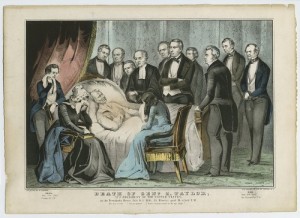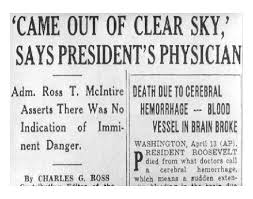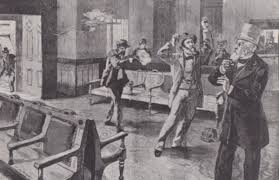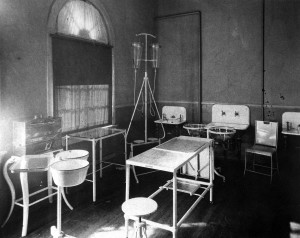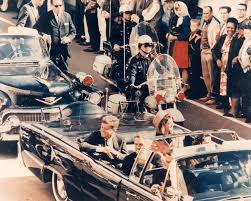A History of Dead Presidents from Producergirl Productions on Vimeo.
h3>
Presidents and Death
Being President is deadly. Of the eight who died in office, seven of them would have been saved by modern medicine. In some cases, the president’s died as a result of medical care. This is one reason why people are so interested in the “health” of those who would become president. But lets look at those who died in office and see how modern medicine would have helped them – or not.
Four president’s have died in office without being assassinated. For all of them, their deaths would have been prevented by modern medicine.
William Henry Harrison – died 1841. Pneumonia and then death by bleeding.
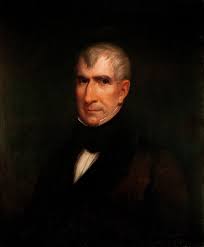
The first president to die in office was William Henry Harrison. Pneumonia exacerbated by bleeding led to his death.
The first was William Henry Harrison, who died of pneumonia in 1841. Some point out his two hour speech after being elected, but it was three weeks later that he became ill with a serious pneumonia. He died 30 days after taking office, so he was not only the first president to die in office, but also served the shortest period of time.
The doctor’s who treated him used bleeding, herbs, and other nonsense leading to his rapid demise. It is odd that in the modern era with antibiotics we still have people who practice as they did in 1841, without science and with a lot of nonsense.
Zachary Taylor – died 1850. Death by unpasteurized milk.
Zachary Taylor, the second president to die in office, died in 1850 after eating some raw milk with cherries. Probably from typhoid fever secondary to food poisoning. Conspiracy theories were rampant then, as Taylor was opposed to slavery the one theory is that he was poisoned. In 1991 his remains were tested, and no poison was found. No doubt how he was treated in those days: opium, ipecac, quinine, as well as cupping (like Michael Phelps) and bleeding led to his demise.
Zachary Taylor’s death would have been prevented had he drank pasteurized milk. Odd to think people today want “raw” milk. There are no nutrients lost in pasteurization, but there are a lot of bacteria that survived.
Warren Harding – died 1921. Food Poisoning – the bad crab from Ketchikan, Alaska.
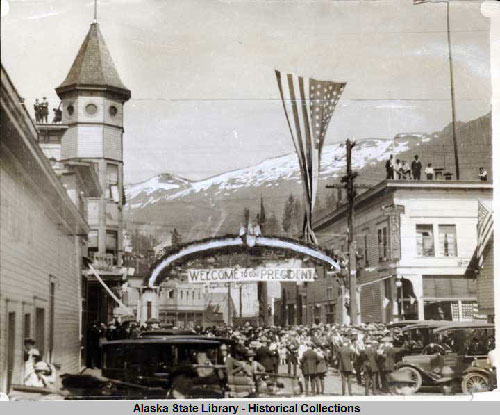
President Harding, the only President to visit my hometown of Ketchikan – was it our crab that killed him?
Warren Harding died after two years in office in 1921. The speculation is food poisoning after a trip to Alaska. He had many signs of exhaustion, including not finishing a round of golf. In my hometown of Ketchikan, Alaska it was widely said he died from the bad crab he was served at one of the local restaurants. While that makes my hometown famous, had Harding been treated with intravenous fluids and antibiotics he would have survived – sadly antibiotics were not available, but intravenous fluids were.
Franklin Roosevelt – died 1945. Stroke secondary to heart failure.
Franklin Roosevelt died in office of a stroke, and had been suffering from congestive heart failure with a very high blood pressure for some time. Because his medical condition was famously protected by the press, it came as a shock when he died. Physicians did not have good treatments for blood pressure, which today would result in immediate hospitalization. His blood pressure was listed in the last year as sometimes being 300/200. Today blood pressure is easily controlled with a wide variety of medications. In those days the treatment of blood pressure was “controversial,” but his death helped usher in the modern treatment of blood pressure.
Three of the presidents who were shot would have been saved by modern medicine
Abraham Lincoln – died 1865. Assassination by gunshot to the head.
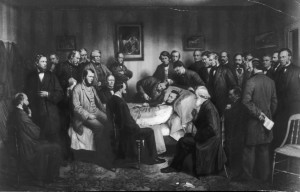
The famous painting of the deathbed of President Lincoln. Today his injury would not have killed him
Four other presidents were assassinated starting with Lincoln in 1865. Although they tried to save him by probing his skull to relieve pressure on his brain he died from the injury that the doctors at the time said was “mortal.”
The headshot that ultimately killed President Lincoln involved no brain tissue. Today, with that same injury, Lincoln would be rushed to a trauma center and undergo surgery on his brain that would have likely resulted in saving his life and allowing him to return to normal function.
James Garfield – died 1881. Assassination by gunshot and death by medical malpractice.
President Garfield’s assassination led to the medical malpractice after his death contributed more to his demise than the gunshot (he spent days being probed, given enemas, and malpractice from a doctor who re-named his first name to “Doctor”). The physician, Dr. D. Willard Bliss, was a civil war surgeon who believed that if you could remove the bullet you could save the soldier. You’ve seen the old Westerns, “gotta get that bullet out.” Mostly those bullets would have been better if they stayed in the person.
Dr Doctor Bliss didn’t believe in the “germ” theory and tortured President Garfield a number of times by going after the bullet with unsterilized probes. Garfield died 88 days later, from multiple infections from the attempts to remove the bullet. When his assassin went to trial his defense was that he didn’t kill the president, but medical malpractice did. He was probably right. Even by the standards of 1880 Dr. Bliss was considered a quack.
The idea that removing the bullet leads to survival was a correlation not a causation. If the bullet is easily found and removed a person is likely to survive. But probing wounds with unsterile instruments is never a good idea.
Had the bullet been left in President Garfield and Dr. Doctor Bliss never been called, he would have likely survived.
William McKinley – died 1901. Assassination by gunshot death by pancreatitis.
McKinley’s assassination in 1901 was noted for his fast operation and discharge (modern medicine at its finest).
McKinley was attending the World’s Exposition in 1901, famous for showing off electricity. The Exposition had an operating room on the grounds. After McKinley was shot he was quickly transported to an operating room by an electric car (not a Tesla). At surgery the bullet in his stomach was removed and the stomach was repaired expertly. McKinley was discharged 3.5 hours after he was shot.
Unfortunately McKinley developed an inflammation of his pancreas and died later from those complications. Some have speculated that the surgeon missed the backside of the stomach – but the surgeon did not.
Today treatment of pancreatitis is with intravenous fluids and monitoring, not available even though he had excellent surgical care.
John F. Kennedy – died 1963. Fatal gunshot wound.
The death of John Kennedy continued the long line of speculation as to who killed him and what conspiracy was involved. By all notes the fatal head wound was instantly fatal. One of my surgical mentors was present when Kennedy arrived at Parkland Hospital and noted that the president was “deader than a doornail.” Still they attempted CPR on the president because the surgeons at the time recognized what it would mean to the country to have this young leader die.
When counting our 44 presidents, 8 have died in office, 4 from guns, 2 from from food poisoning, and 1 from complications of heart failure. That is a stunning 18 per cent! But only one of them died from a diagnosable condition that would have been known on the campaign trail.
Had President Regan been president twenty years before he would not have survived his bullet wounds.
But as a physician, of those presidents who died in office died from “modern” medicine at the time. Of the eight who died, seven would likely have survived if treated by today’s standards.

